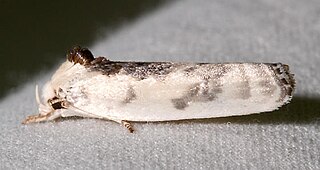
Antaeotricha is a genus of moths. It is the largest genus in the subfamily Stenomatinae, numbering over 400 species in the Western Hemisphere.
Acleris stadiana is a species of moth of the family Tortricidae first described by William Barnes and August Busck in 1920. It is found in North America, where it has been recorded from Ontario.
Agonopterix latipalpella is a moth in the family Depressariidae. It was described by William Barnes and August Busck in 1920. It is found in North America, where it has been recorded from Texas.
Agonopterix pteleae is a moth in the family Depressariidae. It was described by William Barnes and August Busck in 1920. It is found in North America, where it has been recorded from Illinois, Michigan and Ohio.
Chionodes psiloptera is a moth in the family Gelechiidae first described by William Barnes and August Busck in 1920. It is found in North America, where it has been recorded from Quebec to British Columbia and then to Alaska, eastern Washington, Montana and New York.
Chionodes retiniella is a moth in the family Gelechiidae first described by William Barnes and August Busck in 1920. It is found in North America, where it has been recorded from Idaho, Wyoming, Nevada, British Columbia, Washington, Colorado, New Mexico, Arizona and California.
Chionodes xanthophilella is a moth in the family Gelechiidae first described by William Barnes and August Busck in 1920. It is found in North America, where it has been recorded from California, Arizona, Nevada, New Mexico, Texas and North Dakota.
Coleotechnites elucidella is a moth of the family Gelechiidae described by William Barnes and August Busck in 1920. It is found in North America, where it has been recorded from California.

Teleiopsis baldiana is a moth of the family Gelechiidae described by William Barnes and August Busck in 1920. It is found in North America, where it has been recorded from California.
Gelechia benitella is a moth of the family Gelechiidae described by William Barnes and August Busck in 1920. It is found in North America, where it has been recorded from Texas.
Prolita rectistrigella is a moth of the family Gelechiidae. It was described by William Barnes and August Busck in 1920. It is found in North America, where it has been recorded from California, Arizona, New Mexico, Colorado, Utah, Wyoming, Montana, Washington and Alberta.
Anacampsis psoraliella is a moth of the family Gelechiidae. It was described by William Barnes and August Busck in 1920. It is found in North America, where it has been recorded from Iowa.
Aristotelia lindanella is a moth of the family Gelechiidae. It was described by William Barnes and August Busck in 1920. It is found in North America, where it has been recorded from California.
Aristotelia monilella is a moth of the family Gelechiidae. It was described by William Barnes and August Busck in 1920. It is found in North America, where it has been recorded from Illinois, Kentucky, North Carolina and Florida.
Isophrictis actiella is a moth of the family Gelechiidae, described by William Barnes and August Busck in 1920. It is found in North America, where it has been recorded from California.
Taygete citrinella is a moth in the family Autostichidae. It was described by William Barnes and August Busck in 1920. It is found in North America, where it has been recorded from Arizona and California.
Antaeotricha decorosella is a moth in the family Depressariidae. It was described by August Busck in 1908. It is found in North America, where it has been recorded from New Jersey, Indiana, North Carolina, Florida and Massachusetts.
Antaeotricha extenta is a moth in the family Depressariidae. It was described by August Busck in 1920. It is found in Guatemala and Panama.
Antaeotricha irene is a moth in the family Depressariidae. It was described by William Barnes and August Busck in 1920. It is found in North America, where it has been recorded from Texas.
Antaeotricha thomasi is a moth in the family Depressariidae. It was described by William Barnes and August Busck in 1920. It is found in North America, where it has been recorded from Arizona, New Mexico and Colorado.

